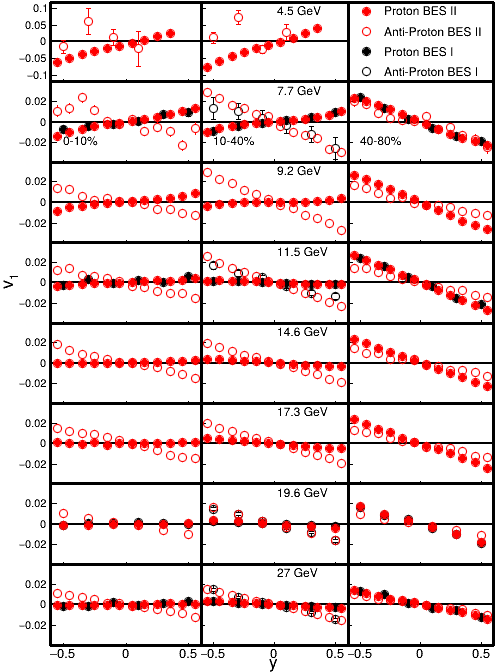Directed Flow of Protons and Anti-Protons in RHIC Beam Energy Scan II
Abstract

Figure 1: Proton (filled circles) and Anti-Proton (open circles) directed flow with respect to rapidity for central (0-10%) mid-central (10-40%) and peripheral (40-80%) collisions for BES I (black) and BES II (red) energies.
.png)
.png)
Figure 2: Excess Proton v1 vs. normalized rapidity for all BES II collider energies as well as the BES I Excess Proton v1 results for $\sqrt{s_{NN}}=200 GeV$ for 10-40% centrality. We see that from 200 GeV down to 14.6 GeV all measurements fall along the same slope, breaking scale for 11.5 GeV and lower. The fit line is an odd third order polynomial of 14.6,17.3,19.6,27 and 200 GeV datapoints.
.png)
Figure 3: Proton, Anti-Proton, and Excess v1 slope with respect to normalized rapidity versus collision energy at 10-40% centrality. We see excess v1 scales with beam rapidity from 200 GeV down to at least 14.6 GeV. The JAM Mean Field Model seems to qualitatively describe the behavior more accurately than JAM Cascade. The JAM Mean Field is close to data at 14.6 and 19.6 GeV, but cannot simultaneously reproduce the result at 7.7 GeV. Extending to lower energies, there is clear breaking of scaling at or above 7.7 GeV with the BES-II dataset analysis, indication change in medium and collision dynamics at 7.7 GeV.
Conclusion:
In this work we have completed the precision measurement of the proton and antiproton directed flow as a function of rapidity for all the collider BES II energies, significantly increasing the accuracy over the BES I measurements. We see that looking at the excess v1 of protons gives us a constant slope with respect to normalized rapidity from 200 GeV down to 14.6 GeV, and that this scaling deviates from this constant value at 11.5 GeV and below, indicating a change in the medium or collision dynamics. When compared to mean field calculations, the data has a lower slope than predicted even for the softest equation of state. This new variable gives us a new avenue to probe the equation of state.
- educkwort's blog
- Login or register to post comments
